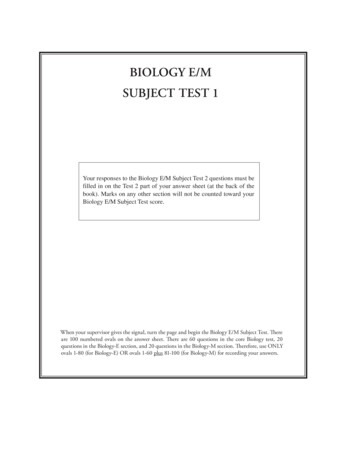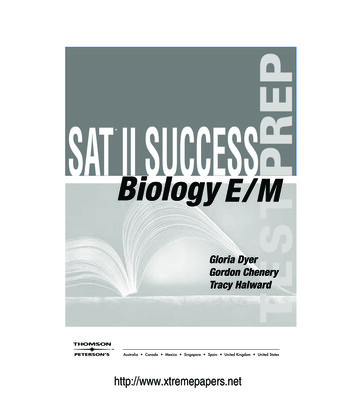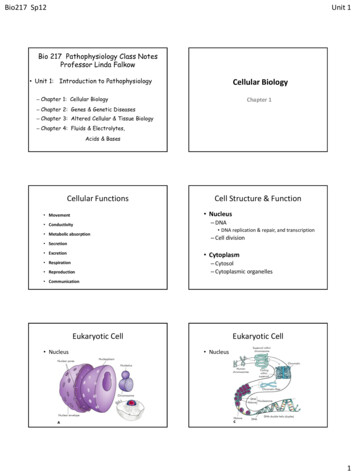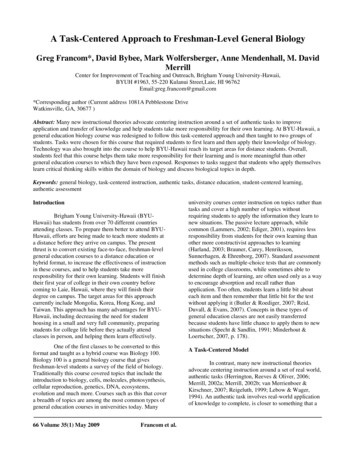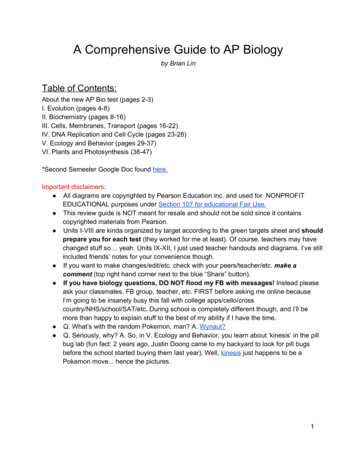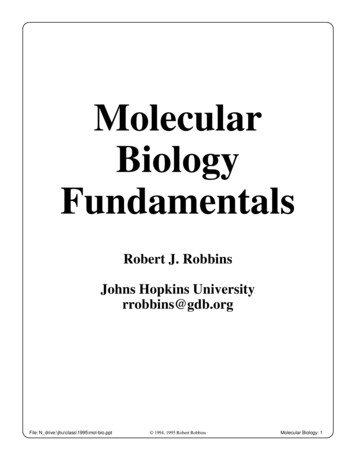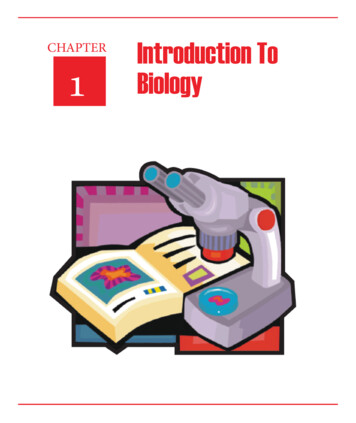
Transcription
CHAPTER1Introduction ToBiology
eLearn.Punjab1. Introduction to BiologyScience is the study in which observations are made,experiments are done and logical conclusionsare drawn in order to understand the principles of nature.In ancient times, the scientific information was not classified into different branches, as it existstoday. All the scientific information was included under one head i.e. ‘science’. With the passage oftime scientific information increased many folds and this enormous scientific knowledge was thenclassified into different branches like, biology, physics, chemistry, mathematics etc.Scientific knowledge is the common heritage of mankind.Dr. Abdus Salam1.1 Introduction To BiologyBiology is the scientific study of life. The word “biology” has been derived from two Greek words; ‘bios’meaning ‘life’ and ‘logos’ meaning ‘thought or reasoning’. In the course of biology, we will study howman has thought about living things. To understand and appreciate nature, it is essential to studythe structures, functions and related aspects of living organisms. The study of living organisms alsoprovides information and remedies to human problems regarding health, food, environment etc.Animation 1.1: MicroscopeSource & Credit: savillbiology2V: 1.1
eLearn.Punjab1. Introduction to Biology1.1.1 Divisions and Branches of BiologyThere are three major divisions of biology which study the different aspects of the lives of themajor groups of organisms.ZOOLOGYThis division of biology deals with the study of animals.BOTANYThis division of biology deals with the study of plants.MICROBIOLOGYThis division of biology deals with the study of microorganisms such as bacteria etc.In order to study all the aspects of life, these divisions are further divided into different branchesas defined below.MorphologyThis branch deals with the study of form and structures of living organisms.Molecular biology (biochemistry) deals with the study of the molecules of life; e.g. water,proteins, carbohydrates, lipids, and nucleic acids.AnatomyThe study of internal structures is called anatomy.HistologyThe microscopic study of tissues is called histology.Cell biologyThe study of the structures and functions of cells and cell organelles is called cell biology. Thisbranch also deals with the study of cell division.PhysiologyThis branch deals with the study of the functions of different parts of living organisms.3V: 1.1
eLearn.Punjab1. Introduction to BiologyGeneticsThe study of genes and their roles in inheritance is called genetics. Inheritance means thetransmission of characters from one generation to the other.EmbryologyIt is the study of the development of an embryo to new individual.TaxonomyIt is the study of the naming and classification of organisms into groups and subgroups.PalaeontologyIt is the study of fossils, which are the remains of extinct organisms.Environmental biologyIt deals with the study of the interactions between the organisms and their environment.Socio-biologyThis branch deals with the study of social behaviour of the animals that make societies.Parasites are the organisms that take food and shelter from living hosts and, in return,harm them.Parasitology:This branch deals with the study of parasites.Biotechnology:It deals with the practical application of living organisms to make substances for the welfare ofmankind.ImmunologyIt is the study of the immune system of animals, which defends the body against invading microbes.EntomologyIt is the study of insects.4V: 1.1
eLearn.Punjab1. Introduction to BiologyPharmacologyIt is the study of drugs and their effects on the systems of human body.Human population growth, infectious diseases, addictive drugs and pollution are the majorbiological issues today.1.1.2 Relationship of biology to other sciencesThe interrelationship among different branches of science cannot be denied. Biology includesinformation on various aspects of living things but these information relate to the other branchesof science as well. Each branch of science has relationship with all other branches. For example,when studying the process of movement in animals, the biologists have to refer to the laws ofmotion in physics. This forms the basis of interdisciplinary sciences (Figure 1.1).Biophysics:It deals with the study of the principles of physics, which are applicable to biological phenomena.For example there is a similarity between the working principles of lever in physics and limbs ofanimals in biology.Biochemistry:It deals with the study of the chemistry of different compounds and processes occurring in livingorganisms. For example the study of basic metabolism of photosynthesis and respiration involvesthe knowledge of chemistry.Discussion / DebateIdentify and evaluate the impact of scientific ideas and/or advancements in technology on society.Biomathematics / Biometry:It deals with the study of biological processes using mathematical techniques and tools. Forexample to analyze the data gathered after experimental work, biologists have to apply the rulesof mathematics.5V: 1.1
eLearn.Punjab1. Introduction to BiologyBiogeography:It deals with study of the occurrence and distribution of different species of living organisms indifferent geographical regions of the world. It applies the knowledge of the characteristics ofparticular geographical regions to determine the characteristics of living organisms found there.Bioeconomics:It deals with the study of organisms fromeconomical point of view. For examplethe cost value and profit value of theyield of wheat can be calculated throughbioeconomics and benefits or losses can bedetermined.Discussion / DebateIdentify and evaluate the impact ofscientific ideas and/or advancementsin technology on societyFigure 1.1: Relationship of biology with other sciences1.1.3 Careers In BiologyIt is essential that students of today, who will occupy positions of leadership tomorrow, have thebackground of the modern and forward-looking branches of science. An accurate and modernknowledge of biology, will promote a comprehension of both science and scientific researchprojects. It will benefit the learners in diverse list of careers. The following are the careers that astudent of biology can plan to adopt.Medicine / Surgery:The profession of medicine deals with the diagnosis and treatment of diseases in human. In surgerythe parts of the body may be repaired, replaced or removed, for example the removal of stonesthrough renal surgery, transplantation of kidney, liver etc. Both these professions are studied inthe same basic course (MBBS) and then students go for specializations.6V: 1.1
eLearn.Punjab1. Introduction to BiologyFisheries:Fisheries is the professional study of fish production. There are departments in Pakistan whereprofessionals of fisheries are employed. They serve for enhancing the quality and quantity of fishproduction. In Pakistan, this profession can be adopted after the bachelor or masters level studyof zoology and fisheries.Agriculture:This profession deals with the food crops and animals which are the source of food. An agriculturistworks for the betterment of crops like wheat, rice, corn etc and animals like buffalo cow etc fromwhich we get food. In Pakistan there are many universities which offer professional courses onagriculture after the higher secondary education in biology.Animal husbandry:It is the branch of agriculture concerned with the care and breeding of domestic animals (livestock)e.g. cattle, sheep etc. Professional courses in animal husbandry can be adopted after the highersecondary education in biology.Horticulture:It deals with the art of gardening. A horticulturist works for the betterment of existing varietiesand for the production of new varieties of ornamental plants and fruit plants. Biology students canadopt this profession after their higher secondary education.Farming:It deals with the development and maintenance of different types of farm. For example in somefarms animal breeding technologies are used for the production of animals which are betterprotein and milk source. In poultry farms chicken and eggs are produced. Similarly in fruit farms,different fruit yielding plants are grown. A student who has gone through the professional courseof agriculture, animal husbandry or fisheries etc. can adopt this profession.Forestry:In forestry, professionals look after natural forests and advises to the government for planting andgrowing artificial forests. Many universities offer professional courses in forestry after the highersecondary education in biology or after bachelor level study of zoology and botany.7V: 1.1
eLearn.Punjab1. Introduction to BiologyBiotechnology:It is the latest profession in the field of biology. Biotechnologists study and work for the productionof useful products through microorganisms. Universities offer courses in biotechnology after thehigher secondary education in biology and after the bachelor level studies of botany or zoology.1.1.4 Quran and biologyAt many places in Holy Quran, Allah hints about the origin and characteristics of living organisms.In the same verses human beings have been instructed to expose the unknown aspects of life, aftergetting the hints. Here are few examples of such guidelines.“We made every living thing from water.”(Sura: Ambia, Verse: 30)We know that water makes the 60-70% of the composition of protoplasm of all living things. Theabove Verse hints at the common origin of all living things in water. As Allah has ordered humanbeings to think at the hints given by Him, we should study living things so that the mysteries oftheir origin can be revealed.“He made man from clay like the potter.”(Sura: Rehman, Verse: 14)In another verse, God says:8V: 1.1
eLearn.Punjab1. Introduction to Biology“Then fashioned We the drop a clot, then fashioned We the clot a little lump, thenfashioned We the little lump bones, then clotted the bones with flesh”(Sura: Al-Mominoon, Verse: 14)When we think at the hints given in both these Verses, we find the events that occurred in thecreation of human beings. Allah also hints at the method of the development of animals includinghuman beings.“Allah hath created every animal from water. Then some of them creep up over theirbellies, others walk on two legs, and others on four. Allah creates what He pleases.”(Sura: Al-Nur, Verse: 45)This Verse describes the common origin and modification of organisms and also supports themodern concepts of classification.Thus, Quran hints not only at the origin and development of life but also at many characteristics ofliving organisms.1.2 Muslim ScientistsMuslim scientists have made great contributions to the study of science and we are aware of theirsuccess in different fields of science. Here we would summarize the work of Jabir Bin Hayan, AbdulMalik Asmai and Bu Ali Sina in the development of the present day knowledge of plants and animals.Jabir Bin Hayan (721 - 815 AD):He was born in Iran and practised medicine in Iraq. He introduced experimental investigation inchemistry and also wrote a number of books on plants and animals. His famous books are “AlNabatat” and “Al-Haywan”.Abdul Malik Asmai (740 - 828 AD):He is considered the first Muslim scientist who studied animals in detail. His famous writings include“Al-Abil (camel)”, “Al-Khail (horse)”, “Al-Wahoosh (animal)”, and “Kalq al-Ansan”.9V: 1.1
eLearn.Punjab1. Introduction to BiologyBu Ali Sina (980 - 1037 AD):He is honoured as the founder of medicine and called as Avicenna in the West. He was a physician,philosopher, astronomer and poet. One of his books “Al-Qanun-fi al-Tib” is known as the canon ofmedicine in West.Bu Ali SinaJabir Bin Hyan1.3 The Levels Of OrganizationIn order to understand the various phenomena of life, biologists study biological organization atdifferent levels, which are as follows.1. Subatomic and Atomic levelAll types of matter are made up of elements and each element contains a single kind of atoms (‘a’:not, ‘tom’: cut). The atoms are actually made up of many subatomic particles.The most stable subatomic particles are electrons, protons and neutrons. Out of the 92 kinds ofelements that occur in nature, 16 are called bioelements. These take part in making the body massof a living organism (Figure 1.2). Out of these bioelements; Only six (O, C, H, N, Ca, & P) make 99%of the total mass. Other ten (K, S, Cl, Na, Mg, Fe, Cu, Mn, Zn, & I) collectively make 01% of the totalmass.RecallingProtons and neutrons are located inside nucleus of atom while electrons orbit in energy levels(electrons shells) around the nucleus. The number of electrons in the outermost shell determinesthe manner in which atoms react with each other.10V: 1.1
eLearn.Punjab1. Introduction to BiologyFigure 1.2: Percentage composition (by mass) of bioelements in the protoplasm of living organismsRecallingA molecule is the smallest part of a compound that retains the properties of that compound.2. Molecular levelIn organisms, bioelements usually do not occur in isolated forms rather they combine throughionic or covalent bonding. The stable particle formed by such bonding is called as molecule orbiomolecule.An organism is formed by enormous number of biomolecules of hundreds of different types.These molecules are the building material and are themselves constructed in great variety andcomplexity due to specific bonding arrangements. Biomolecules are classified as micromoleculesand macromolecules. Micromolecules are with low molecular weight e.g. glucose, water etc. andmacromolecules are with high molecular weights e.g. starch, proteins, lipids etc.11V: 1.1
eLearn.Punjab1. Introduction to Biology3. Organelle and Cell levelBiomolecules assemble in a particular way and form organelles. The organelles are actually subcellular structures and when they assemble together, units of life i.e. cells are formed.Each type of organelle is specialized to perform a specific function. For example; mitochondriaare specialized for cellular respiration and ribosomes are specialized for protein synthesis. In thisway, functions of the cell are accomplished by these specialized structures. It is an example of thedivision of labour within the cell.In the case of prokaryotes and most protists, the entire organism consists of a single cell. In thecase of most fungi, all animals and all plants, the organism consists of up to trillions of cells.4. Tissue levelIn multicellular organisms, similar cells (performing similar functions) are organized into groups,called tissues. We can define a tissue as a group of similar cells specialized for the performance ofa common function. Each cell in a tissue carries on its own life processes (like cellular respiration,protein synthesis), but it also carries on some special processes related to the function of the tissue.There are different types of plant tissues e.g. epidermal tissue, ground tissue, etc. Animal tissuesare also of different types e.g. nervous tissue, muscular tissues etc.5. Organ and Organ system levelIn higher multicellular organisms more than one type of tissue having related functions are organizedtogether and make a unit, called organ. Different tissues of an organ perform their specific functionsand these functions collectively become the function/s of that organ. For example stomach is anorgan specialized for the digestion of proteins and for storing food. Two major types of tissueare present in its structure. Epithelial (glandular) tissue secretes gastric juice for the digestion ofproteins.Muscular tissue performs contractions of stomach walls for grinding of food and moving foodto posterior end. So two tissues perform their specific functions, which collectively become thefunction of stomach.The next level of organization in multicellular organisms is the organ system level. Different organsperforming related functions are organized together in the form of an organ system. In an organsystem, each organ carries out its specific function and the functions of all organs appear as thefunction of the organ system. For example, digestive system is an organ system that carries out the12V: 1.1
eLearn.Punjab1. Introduction to Biologyprocess of digestion. Major organs in its framework are oral cavity, stomach, small intestine, largeintestine, liver, and pancreas. All these organs help in the process of digestion.The organ system level is less complex in plants (e.g. root system) as compared to animals. This isdue to a greater range of functions and activities in animals than in plants.6. Individual levelDifferent organs and organ systems are organized together to form an individual or organism.In organism, the functions, processes and activities of various organs and organ systems arecoordinated. For example, when a man is engaged in continuous and hard exercise, not only hismuscles are working but also there is an increase in the rate of respiration and heart beat. Thisaccelerated rate of respiration and heart beat supplies more oxygen and food to the muscles whichthey need for continuous work.7. Population levelBiologists extend their studies to the population level where they study interactions among memberof the same species living in the same habitat. A population is defined as a group of organisms ofthe same species located at the same place, in the same time. For example, human population inPakistan in 2010 comprises of 173.5 million individuals (according to the Ministry of PopulationWelfare, Government of Pakistan).A species is defined as a group of organisms capable of interbreeding and producing fertileoffspring.Habitat means the area of the environment in which organism lives.13V: 1.1
eLearn.Punjab1. Introduction to Biology8. Community LevelA community is an assemblage of different populations, interacting with one another withinthe same environment. A forest may be considered as a community. It includes different plant,microorganisms, fungi and animal species. Communities are collections of organisms, in which onepopulation may increase and others may decrease. Some communities are complex e.g. a forestcommunity, a pond community etc. Other communities may be simple e.g. a fallen log with variouspopulations under it. In a simple community number and size of populations is limited. So anychange in biotic or abiotic factors may have drastic and long lasting effects.9. Biosphere levelThe part of the Earth inhabited by organisms’ communities is known as biosphere. It constitutesall ecosystems (areas where living organisms interact with the nonliving components of theenvironment) and is also called the zone of life on Earth.1.3.1 Cellular organizationsAll the organisms have been divided into five major groups i.e. prokaryotes, protists, fungi, plantsand animals. All organisms are made of cells. There are two basic types of cells. The organisms infirst group are made of prokaryotic cells while all other groups have eukaryotic cells.Cells organize in three ways to make the bodies of organisms. Cells make unicellular, colonials andmulticellular organizations and the organisms formed through these organizations are unicellularorganisms, colonial organisms and multicellular organisms.In unicellular organisms, only one cell makes the life of an organism. All the life activities arecarried out by the only cell. Amoeba, Paramecium, and Euglena are common examples (Figure 1.4).14V: 1.1
eLearn.Punjab1. Introduction to BiologyFigure 1.3: Levels of organization15V: 1.1
1. Introduction to BiologyeLearn.PunjabFigure 1.4: Amoeba, Paramecium and EuglenaIn colonial type of cellular organization, many unicellularorganisms live together but do not have any division oflabour among them. Each unicellular organism in a colonylives its own life and does not depend on other cells for itsvital requirements. Volvox is a green alga found in waterthat shows colonial organization. Hundreds of Volvox cellsmake a colony (Figure 1.5).In multicellular organization, cells are organized inthe form of tissues, organs and organ systems. Frogand mustard are the familiar examples of multicellularorganization.Figure 1.5: Volvox colonyMustard plantMustard plant (scientific name: Brassica campestris) is sown in winter and it produces seeds at theend of winter. The plant body is used as vegetable and its seeds are used for extracting oil. Theorgans of the body can be divided into two groups on the basis of their functions. Root, stem,branches and leaves are the vegetative organs, which do not take part in the sexual reproductionof the plant. Flowers are the reproductive parts of the plant because they take part in sexualreproduction and produce fruits and seeds. (Figure 1.6)16V: 1.1
1. Introduction to BiologyeLearn.PunjabAnalyzing and Interpreting:FrogFrog (scientific name: Rana tigrina) shows the multicellular Describe the main organs of theorganization. The body is made of organ systems and each mustard by observing a specimen.organ system consists of related organs. All the organs aremade of specific tissues (epithelial, glandular, muscular,nervous etc). Some organs and organ systems of frog havebeen described in the practical activity given next.Figure 1.7: FrogFigure 1.6: MustardAnalyzing and InterpretingIdentify different tissues in the photomicrographs of different organs.Practical Work:Identification of organs and organ systems in a dissected frogThe multicellular organization can be studied in a dissected frog. Different organs and organ systemscan be identified and compared with the diagrams or figures given in books or charts.Problem:Identify the organs that make up the internal systems of the frog.Purpose:In laboratory, the teacher will dissect a frog in order to expose its external and internal structures.Background information:Frog belongs to the class amphibia of the animal kingdom. It possesses multicellular organizationconsisting of tissues, organs and organ systems.17V: 1.1
1. Introduction to BiologyeLearn.Punjab On the outside of the frog’s head are two external nostrils; two tympani, or eardrums; and twoeyes, each of which has three lids. The third lid, called the nictitating membrane, is transparent. The digestive system consists of the organs of the digestive tract and the digestive glands. The respiratory system consists of the nostrils and the larynx, which opens into two lungs. The circulatory system consists of the heart, blood vessels, and blood. The urinary system consists of the kidneys, ureters, bladder, and cloaca. The organs of the male reproductive system are testes, sperm ducts, and cloaca. The femalesystem consists of ovaries, oviducts, uteri, and cloaca. The central nervous system of frog consists of the brain, which is enclosed in the skull, and thespinal cord, which is enclosed in the backbone. Nerves branch out from brain and spinal cord. The frog’s skeletal and muscular systems consist of its framework of bones, to which all theskeletal muscles of the body are attached.Material Required: Preserved frog, dissecting tray, paper towels and dissecting kitProcedure:The teacher will place an unconscious frog on a dissection tray on its back and pin down the legs.From the ventral side, he / she will lift the skin and use scissors to cut along the center of the bodyfrom the cloaca to the lip. He / she will turn back the skin, cut toward the side at each leg, and pinthe skin flat. Then he / she will lift and cut through the muscles and breast bone to open up thebody cavity.1. Use the diagram below (Figure 1.8) to locate and identify the organs of the digestive system:esophagus, stomach, small intestine, large intestine, cloaca, liver, gallbladder, and pancreas.2. Again refer to the diagram below to identify the parts of the circulatory and respiratory systemsthat are in the chest cavity. Find the left atrium, right atrium , and ventricle of the heart. Find thetwo lungs.3. Use a probe and scissors to lift and remove the intestines and liver. Identify the parts of theurinary and reproductive systems. Find the ureters; the urinary bladder; the testes and spermducts in the male; and the ovaries, oviducts, and uteri in the female.4. Remove the kidneys and look for threadlike spinal nerves that extend from the spinal cord.5. Dispose of your materials according to the directions from your teacher.6. Clean up your work area and wash your hands before leaving the lab.18V: 1.1
1. Introduction to BiologyeLearn.PunjabObservation: After identifying the important organs and organ systems, draw your observation inthe form of diagrams.Figure 1.8: Anatomy of dissected frogEvaluation:1. What may be the purpose of nictitating membrane in frog?2. On which side of body did you see the kidneys? Dorsal or ventral?3. Which part is the common passage in the digestive, excretory and reproductive systems?4. What was the sex of the dissected frog? How would you differentiate male and female frogswhile looking at their anatomy?19V: 1.1
1. Introduction to BiologyeLearn.PunjabUNDERSTANDING THE CONCEPTS1. Arrange these structures in order of lower level of organization to upper level and write thelevel against each structure. Neuron, nervous system, electron, man, mass of neurons, carbon,mitochondria, brain, protein2. How would you define biology and relate it with its major divisions?3. Draw a table showing the branches of biology and the studies these deal with.4. Give points to advocate that Biology is linked with physics, chemistry, mathematics, geographyand economics.5. How would you distinguish the biomolecules from other molecules? What is the criterion forclassifying a biomolecule as micromolecule or macromolecule?6. Describe the levels of organization of life.7. Is there any division of labour among the cells of a colony? If you find division of labour amongthe cells and tissue what level of cellular organization is it?SHORT QUESTIONS1. Define biotechnology.2. What do you mean by horticulture and how is it related to agriculture?THE TERMS TO KNOWAgricultureAnatomyAnimal technologyBotanyCellCell ental ganOrgan ogyV: 1.1
1. Introduction to BiologyeLearn.PunjabINITIATING AND PLANNING1. Draw a linkage chart connecting different organs with the relative organ systems.ANALYZING AND INTERPRETING1. Identify different tissues in the photomicrographs of different organs.ACTIVITIES1. Identify major organs and organ systems in a dissected frog (Dissection by teacher / demonstrator).SCIENCE, TECHNOLOGY AND SOCIETY1. Identify and evaluate the impact of scientific ideas and/or advancements in technology on society.2. List organs of human body that some notorious diseases of today damage and specify the ones,which can be transplanted.ON-LINE /Branches of V: 1.1
CHAPTER2Solving A BiologicalProblemAnimation 2.1: Solving A Biological ProblemSource & Credit: Wikispace
eLearn.Punjab2. Solving a Biological ProblemScience is the systemized knowledge derived from observations and experiments.These experimentsare carried out to determine the principles about how nature operates. Scientists like chemists,biologists and physicists use the same scientific method to make and test new theories.In this chapter, we will study the steps of biological method. We will study malaria as an exampleto understand the steps in detail.2.1 Biological MethodQuestions about living things have provided problems that man has investigated to aid his ownsurvival and to satisfy his desire to know. The scientific method in which biological problems aresolved, is termed as biological method. It comprises the steps a biologist adopts in order to solve abiological problem.Biological method has played an importantpart in scientific research for almost500 years. From Galileo’s experiment(in the 1590s) to current research, thebiological method has contributed tothe advancements in medicine, ecology,technology etc. Biological method alsoensures the quality of data for public useMan has always been a biologist. He had to be abiologist in order to live. Early in history, he was ahunter of animals and a gatherer of fruits, seeds,roots etc. The more he knew about animals and theirhabitat, the more successful hunter he was. The morehe knew about plants, the better he distinguishedbetween edible and non-edible plants.2.1.1 Biological problem, hypothesis, deductions and experimentsIn biology (like other sciences), new things are being discovered and long-held theories are beingmodified or replaced with better ones as more data/knowledge is accumulated. This happens whenbiologists recognize some biological problem and go for its solution. In solving a biological problem,biologist takes following steps; Recognition of biological problem Observations Hypothesis formulation Deductions2V: 1.1
eLearn.Punjab2. Solving a Biological Problem Experimentation Summarization of results (create tables, graphics etc) Reporting the resultsThe details of these steps are as under:1. Recognition of the Biological ProblemBiologists go for adopting biological method when they encounter some biological problem. Abiological problem is a question related to living organisms that is either asked by some one orcomes in biologist’s mind by himself.2. ObservationsAs the first step in solving a biological problem, biologist recalls his/her pr
classified into different branches like, biology, physics, chemistry, mathematics etc. 1.1 Introduction To Biology Biology is the scientific study of life. The word "biology" has been derived from two Greek words; 'bios' meaning 'life' and 'logos' meaning 'thought or reasoning'. In the course of biology, we will study how



